正文
堆內存(Heap Memory)是一個很有意思的領域。你可能和我一樣,也困惑于下述問題很久了:
如何從內核申請堆內存?
誰管理它?內核、庫函數,還是應用本身?
內存管理效率怎么這么高?!
堆內存的管理效率可以進一步提高嗎?
最近,我終于有時間去深入了解這些問題。下面就讓我來談談我的調研成果。
開源社區公開了很多現成的內存分配器(Memory Allocators,以下簡稱為分配器):
dlmalloc – 第一個被廣泛使用的通用動態內存分配器;
ptmalloc2 – glibc 內置分配器的原型;
jemalloc – FreeBSD & Firefox 所用分配器;
tcmalloc – Google 貢獻的分配器;
libumem – Solaris 所用分配器;
…
每一種分配器都宣稱自己快(fast)、可拓展(scalable)、效率高(memory efficient)!但是并非所有的分配器都適用于我們的應用。內存吞吐量大(memory hungry)的應用程序,其性能很大程度上取決于分配器的性能。
在這篇文章中,我只談「glibc malloc」分配器。為了方便大家理解「glibc malloc」,我會聯系最新的源代碼。
歷史:ptmalloc2 基于 dlmalloc 開發,其引入了多線程支持,于 2006 年發布。發布之后,ptmalloc2 整合進了 glibc 源碼,此后其所有修改都直接提交到了 glibc malloc 里。因此,ptmalloc2 的源碼和 glibc malloc 的源碼有很多不一致的地方。(譯者注:1996 年出現的 dlmalloc 只有一個主分配區,該分配區為所有線程所爭用,1997 年發布的 ptmalloc 在 dlmalloc 的基礎上引入了非主分配區的概念。)
1. 申請堆的系統調用
我在之前的文章中提到過,malloc內部通過brk或mmap系統調用向內核申請堆區。
譯者注:在內存管理領域,我們一般用「堆」指代用于分配動態內存的虛擬地址空間,而用「棧」指代用于分配靜態內存的虛擬地址空間。具體到虛擬內存布局(Memory Layout),堆維護在通過brk系統調用申請的「Heap」及通過mmap系統調用申請的「Memory Mapping Segment」中;而棧維護在通過匯編棧指令動態調整的「Stack」中。在 Glibc 里,「Heap」用于分配較小的內存及主線程使用的內存。
下圖為 Linux 內核 v2.6.7 之后,32 位模式下的虛擬內存布局方式。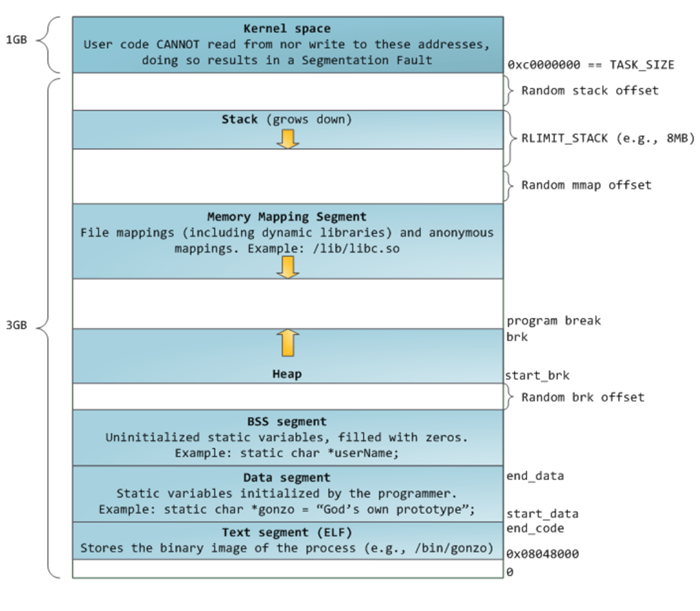
2. 多線程支持
Linux 的早期版本采用 dlmalloc 作為它的默認分配器,但是因為 ptmalloc2 提供了多線程支持,所以 后來 Linux 就轉而采用 ptmalloc2 了。多線程支持可以提升分配器的性能,進而間接提升應用的性能。
在 dlmalloc 中,當兩個線程同時malloc時,只有一個線程能夠訪問臨界區(critical section)——這是因為所有線程共享用以緩存已釋放內存的「空閑列表數據結構」(freelist data structure),所以使用 dlmalloc 的多線程應用會在malloc上耗費過多時間,從而導致整個應用性能的下降。
在 ptmalloc2 中,當兩個線程同時調用malloc時,內存均會得以立即分配——每個線程都維護著單獨的堆,各個堆被獨立的空閑列表數據結構管理,因此各個線程可以并發地從空閑列表數據結構中申請內存。這種為每個線程維護獨立堆與空閑列表數據結構的行為就「per thread arena」。
2.1. 案例代碼
/*Perthreadarenaexample.*/ #include#include #include #include #include void*threadFunc(void*arg){ printf("Beforemallocinthread1 "); getchar(); char*addr=(char*)malloc(1000); printf("Aftermallocandbeforefreeinthread1 "); getchar(); free(addr); printf("Afterfreeinthread1 "); getchar(); } intmain(){ pthread_tt1; void*s; intret; char*addr; printf("Welcometoperthreadarenaexample::%d ",getpid()); printf("Beforemallocinmainthread "); getchar(); addr=(char*)malloc(1000); printf("Aftermallocandbeforefreeinmainthread "); getchar(); free(addr); printf("Afterfreeinmainthread "); getchar(); ret=pthread_create(&t1,NULL,threadFunc,NULL); if(ret) { printf("Threadcreationerror "); return-1; } ret=pthread_join(t1,&s); if(ret) { printf("Threadjoinerror "); return-1; } return0; }
2.2. 案例輸出
2.2.1. 在主線程 malloc 之前
從如下的輸出結果中我們可以看到,這里還沒有堆段也沒有每個線程的棧,因為 thread1 還沒有創建!
sploitfun@sploitfun-VirtualBox:~/ptmalloc.ppt/mthread$./mthread Welcometoperthreadarenaexample::6501 Beforemallocinmainthread ... sploitfun@sploitfun-VirtualBox:~/ptmalloc.ppt/mthread$cat/proc/6501/maps 08048000-08049000r-xp0000000008:01539625/home/sploitfun/ptmalloc.ppt/mthread/mthread 08049000-0804a000r--p0000000008:01539625/home/sploitfun/ptmalloc.ppt/mthread/mthread 0804a000-0804b000rw-p0000100008:01539625/home/sploitfun/ptmalloc.ppt/mthread/mthread b7e05000-b7e07000rw-p0000000000:000 ... sploitfun@sploitfun-VirtualBox:~/ptmalloc.ppt/mthread$
2.2.2. 在主線程 malloc 之后
從如下的輸出結果中我們可以看到,堆段已經產生,并且其地址區間正好在數據段(0x0804b000 - 0x0806c000)上面,這表明堆內存是移動「Program Break」的位置產生的(也即通過brk中斷)。此外,請注意,盡管用戶只申請了 1000 字節的內存,但是實際產生了 132KB 的堆。這個連續的堆區域被稱為「arena」。因為這個 arena 是被主線程建立的,因此其被稱為「main arena」。接下來的申請會繼續分配這個 arena 的 132KB 中剩余的部分。當分配完畢時,它可以通過繼續移動 Program Break 的位置擴容。擴容后,「top chunk」的大小也隨之調整,以將這塊新增的空間圈進去;相應地,arena 也可以在 top chunk 過大時縮小。
注意:top chunk 是一個 arena 位于最頂層的 chunk。有關 top chunk 的更多信息詳見后續章節「top chunk」部分。
sploitfun@sploitfun-VirtualBox:~/ptmalloc.ppt/mthread$./mthread Welcometoperthreadarenaexample::6501 Beforemallocinmainthread Aftermallocandbeforefreeinmainthread ... sploitfun@sploitfun-VirtualBox:~/lsploits/hof/ptmalloc.ppt/mthread$cat/proc/6501/maps 08048000-08049000r-xp0000000008:01539625/home/sploitfun/ptmalloc.ppt/mthread/mthread 08049000-0804a000r--p0000000008:01539625/home/sploitfun/ptmalloc.ppt/mthread/mthread 0804a000-0804b000rw-p0000100008:01539625/home/sploitfun/ptmalloc.ppt/mthread/mthread 0804b000-0806c000rw-p0000000000:000[heap] b7e05000-b7e07000rw-p0000000000:000 ... sploitfun@sploitfun-VirtualBox:~/ptmalloc.ppt/mthread$
2.2.3. 在主線程 free 之后
從如下的輸出結果中我們可以看到,當分配的內存區域free掉時,其并不會立即歸還給操作系統,而僅僅是移交給了作為庫函數的分配器。這塊free掉的內存添加在了「main arenas bin」中(在 glibc malloc 中,空閑列表數據結構被稱為「bin」)。隨后當用戶請求內存時,分配器就不再向內核申請新堆了,而是先試著各個「bin」中查找空閑內存。只有當 bin 中不存在空閑內存時,分配器才會繼續向內核申請內存。
sploitfun@sploitfun-VirtualBox:~/ptmalloc.ppt/mthread$./mthread Welcometoperthreadarenaexample::6501 Beforemallocinmainthread Aftermallocandbeforefreeinmainthread Afterfreeinmainthread ... sploitfun@sploitfun-VirtualBox:~/lsploits/hof/ptmalloc.ppt/mthread$cat/proc/6501/maps 08048000-08049000r-xp0000000008:01539625/home/sploitfun/ptmalloc.ppt/mthread/mthread 08049000-0804a000r--p0000000008:01539625/home/sploitfun/ptmalloc.ppt/mthread/mthread 0804a000-0804b000rw-p0000100008:01539625/home/sploitfun/ptmalloc.ppt/mthread/mthread 0804b000-0806c000rw-p0000000000:000[heap] b7e05000-b7e07000rw-p0000000000:000 ... sploitfun@sploitfun-VirtualBox:~/ptmalloc.ppt/mthread$
2.2.4. 在 thread1 malloc 之前
從如下的輸出結果中我們可以看到,此時 thread1 的堆尚不存在,但其棧已產生。
sploitfun@sploitfun-VirtualBox:~/ptmalloc.ppt/mthread$./mthread Welcometoperthreadarenaexample::6501 Beforemallocinmainthread Aftermallocandbeforefreeinmainthread Afterfreeinmainthread Beforemallocinthread1 ... sploitfun@sploitfun-VirtualBox:~/ptmalloc.ppt/mthread$cat/proc/6501/maps 08048000-08049000r-xp0000000008:01539625/home/sploitfun/ptmalloc.ppt/mthread/mthread 08049000-0804a000r--p0000000008:01539625/home/sploitfun/ptmalloc.ppt/mthread/mthread 0804a000-0804b000rw-p0000100008:01539625/home/sploitfun/ptmalloc.ppt/mthread/mthread 0804b000-0806c000rw-p0000000000:000[heap] b7604000-b7605000---p0000000000:000 b7605000-b7e07000rw-p0000000000:000[stack:6594] ... sploitfun@sploitfun-VirtualBox:~/ptmalloc.ppt/mthread$
2.2.5. 在 thread1 malloc 之后
從如下的輸出結果中我們可以看到,thread1 的堆段(b7500000 - b7521000,132KB)建立在了內存映射段中,這也表明了堆內存是使用mmap系統調用產生的,而非同主線程一樣使用sbrk系統調用。類似地,盡管用戶只請求了 1000B,但是映射到線程地址空間的堆內存足有 1MB。這 1MB 中,只有 132KB 被設置了讀寫權限,并成為該線程的堆內存。這段連續內存(132KB)被稱為「thread arena」。
注意:當用戶請求超過 128KB(比如malloc(132*1024)) 大小并且此時 arena 中沒有足夠的空間來滿足用戶的請求時,內存將通過mmap系統調用(不再是sbrk)分配,而不論請求是發自 main arena 還是 thread arena。
ploitfun@sploitfun-VirtualBox:~/ptmalloc.ppt/mthread$./mthread Welcometoperthreadarenaexample::6501 Beforemallocinmainthread Aftermallocandbeforefreeinmainthread Afterfreeinmainthread Beforemallocinthread1 Aftermallocandbeforefreeinthread1 ... sploitfun@sploitfun-VirtualBox:~/ptmalloc.ppt/mthread$cat/proc/6501/maps 08048000-08049000r-xp0000000008:01539625/home/sploitfun/ptmalloc.ppt/mthread/mthread 08049000-0804a000r--p0000000008:01539625/home/sploitfun/ptmalloc.ppt/mthread/mthread 0804a000-0804b000rw-p0000100008:01539625/home/sploitfun/ptmalloc.ppt/mthread/mthread 0804b000-0806c000rw-p0000000000:000[heap] b7500000-b7521000rw-p0000000000:000 b7521000-b7600000---p0000000000:000 b7604000-b7605000---p0000000000:000 b7605000-b7e07000rw-p0000000000:000[stack:6594] ... sploitfun@sploitfun-VirtualBox:~/ptmalloc.ppt/mthread$
2.2.6. 在 thread1 free 之后
從如下的輸出結果中我們可以看到,free不會把內存歸還給操作系統,而是移交給分配器,然后添加在了「thread arenas bin」中。
sploitfun@sploitfun-VirtualBox:~/ptmalloc.ppt/mthread$./mthread Welcometoperthreadarenaexample::6501 Beforemallocinmainthread Aftermallocandbeforefreeinmainthread Afterfreeinmainthread Beforemallocinthread1 Aftermallocandbeforefreeinthread1 Afterfreeinthread1 ... sploitfun@sploitfun-VirtualBox:~/ptmalloc.ppt/mthread$cat/proc/6501/maps 08048000-08049000r-xp0000000008:01539625/home/sploitfun/ptmalloc.ppt/mthread/mthread 08049000-0804a000r--p0000000008:01539625/home/sploitfun/ptmalloc.ppt/mthread/mthread 0804a000-0804b000rw-p0000100008:01539625/home/sploitfun/ptmalloc.ppt/mthread/mthread 0804b000-0806c000rw-p0000000000:000[heap] b7500000-b7521000rw-p0000000000:000 b7521000-b7600000---p0000000000:000 b7604000-b7605000---p0000000000:000 b7605000-b7e07000rw-p0000000000:000[stack:6594] ... sploitfun@sploitfun-VirtualBox:~/ptmalloc.ppt/mthread$
3. Arena
3.1. Arena 的數量
在以上的例子中我們可以看到,主線程包含 main arena 而 thread 1 包含它自己的 thread arena。所以線程和 arena 之間是否存在一一映射關系,而不論線程的數量有多大?當然不是,部分極端的應用甚至運行比處理器核數還多的線程,在這種情況下,每個線程都擁有一個 arena 開銷過高且意義不大。所以,arena 數量其實是限于系統核數的。
For32bitsystems: Numberofarena=2*numberofcores. For64bitsystems: Numberofarena=8*numberofcores.
3.2. Multiple Arena
舉例而言:讓我們來看一個運行在單核計算機上的 32 位操作系統上的多線程應用(4 線程,主線程 + 3 個線程)的例子。這里線程數量(4)> 2 * 核心數(1),所以分配器中可能有 Arena(也即標題所稱「multiple arenas」)會被所有線程共享。那么是如何共享的呢?
當主線程第一次調用malloc時,已經建立的 main arena 會被沒有任何競爭地使用;
當 thread 1 和 thread 2 第一次調用malloc時,一塊新的 arena 將被創建,且將被沒有任何競爭地使用。此時線程和 arena 之間存在一一映射關系;
當 thread3 第一次調用malloc時,arena 的數量限制被計算出來,結果顯示已超出,因此嘗試復用已經存在的 arena(也即 Main arena 或 Arena 1 或 Arena 2);
復用:
一旦遍歷到可用 arena,就開始自旋申請該 arena 的鎖;
如果上鎖成功(比如說 main arena 上鎖成功),就將該 arena 返回用戶;
如果沒找到可用 arena,thread 3 的malloc將被阻塞,直到有可用的 arena 為止。
當thread 3 調用malloc時(第二次了),分配器會嘗試使用上一次使用的 arena(也即,main arena),從而盡量提高緩存命中率。當 main arena 可用時就用,否則 thread 3 就一直阻塞,直至 main arena 空閑。因此現在 main arena 實際上是被 main thread 和 thread 3 所共享。
3.3. Multiple Heaps
在「glibc malloc」中主要有 3 種數據結構:
heap_info ——Heap Header—— 一個 thread arena 可以維護多個堆。每個堆都有自己的堆 Header(注:也即頭部元數據)。什么時候 Thread Arena 會維護多個堆呢?一般情況下,每個 thread arena 都只維護一個堆,但是當這個堆的空間耗盡時,新的堆(而非連續內存區域)就會被mmap到這個 aerna 里;
malloc_state ——Arena header—— 一個 thread arena 可以維護多個堆,這些堆另外共享同一個 arena header。Arena header 描述的信息包括:bins、top chunk、last remainder chunk 等;
malloc_chunk ——Chunk header—— 根據用戶請求,每個堆被分為若干 chunk。每個 chunk 都有自己的 chunk header。
注意:
Main arena 無需維護多個堆,因此也無需 heap_info。當空間耗盡時,與 thread arena 不同,main arena 可以通過sbrk拓展堆段,直至堆段「碰」到內存映射段;
與 thread arena 不同,main arena 的 arena header 不是保存在通過sbrk申請的堆段里,而是作為一個全局變量,可以在 libc.so 的數據段中找到。
main arena 和 thread arena 的圖示如下(單堆段):
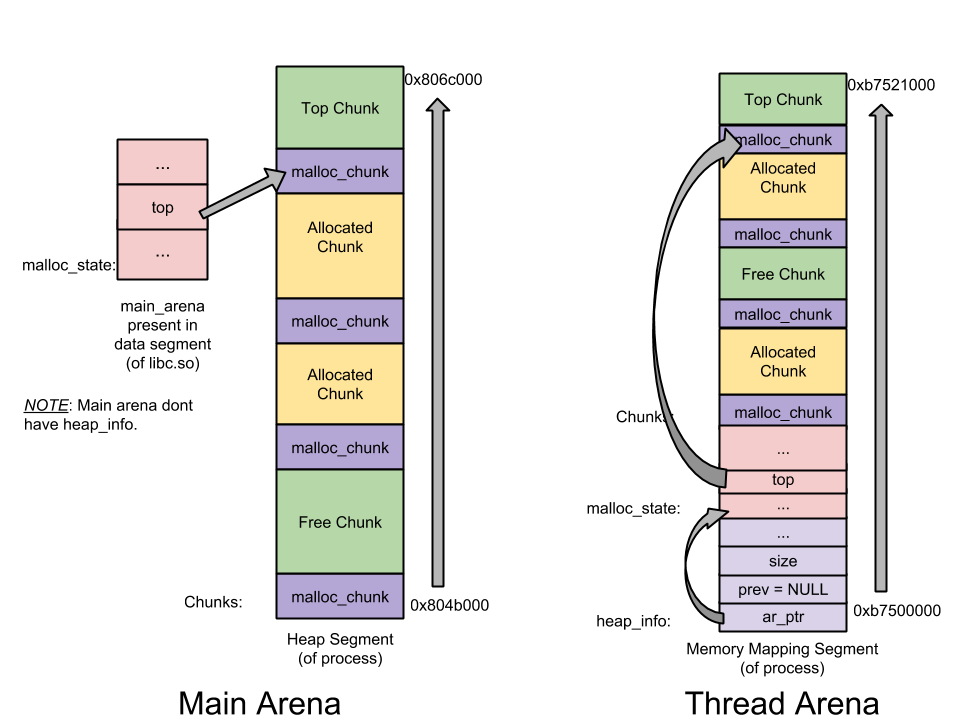
thread arena 的圖示如下(多堆段):
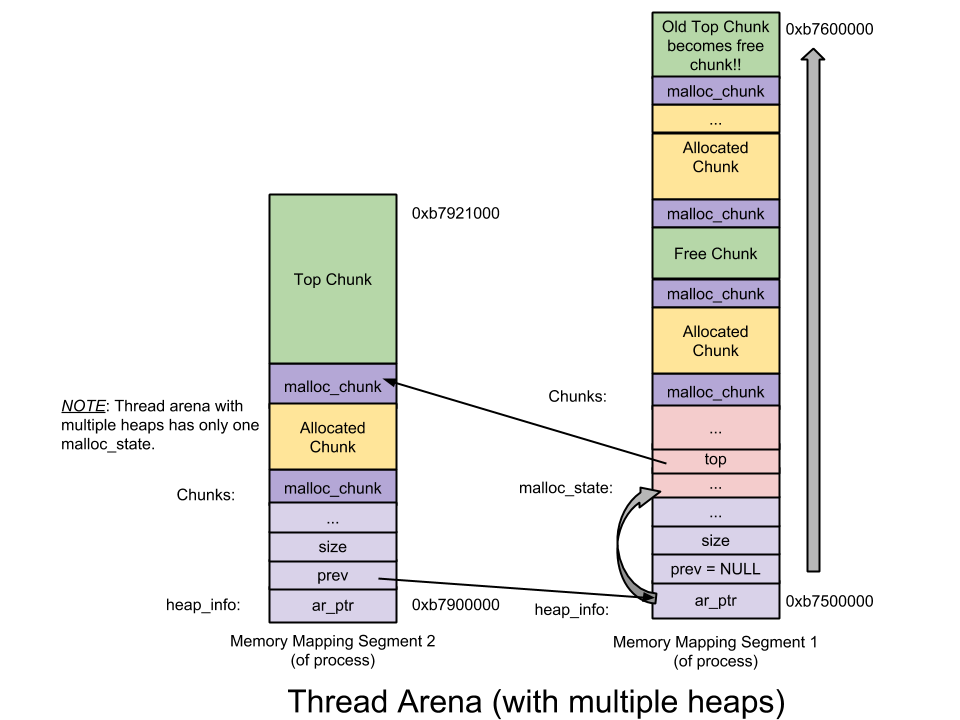
4. Chunk
堆段中存在的 chunk 類型如下:
Allocated chunk;
Free chunk;
Top chunk;
Last Remainder chunk.
4.1. Allocated chunk
「Allocated chunck」就是已經分配給用戶的 chunk,其圖示如下: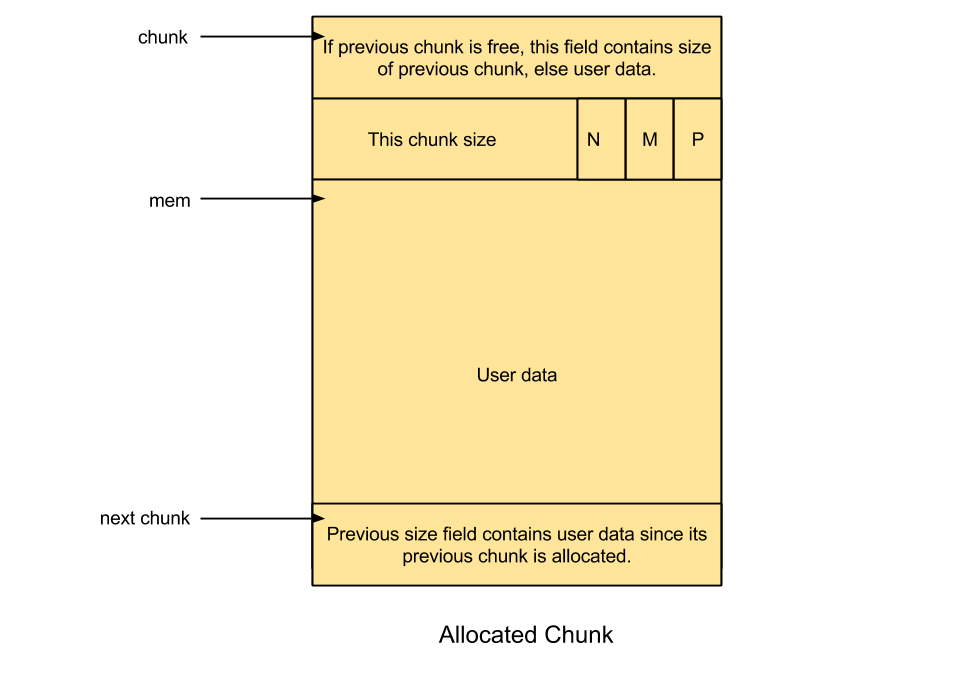
圖中左方三個箭頭依次表示:
chunk:該 Allocated chunk 的起始地址;
mem:該 Allocated chunk 中用戶可用區域的起始地址(= chunk + sizeof(malloc_chunk));
next_chunk:下一個 chunck(無論類型)的起始地址。
圖中結構體內部各字段的含義依次為:
prev_size:若上一個 chunk 可用,則此字段賦值為上一個 chunk 的大小;否則,此字段被用來存儲上一個 chunk 的用戶數據;
size:此字段賦值本 chunk 的大小,其最后三位包含標志信息:
PREV_INUSE § – 置「1」表示上個 chunk 被分配;
IS_MMAPPED (M) – 置「1」表示這個 chunk 是通過mmap申請的(較大的內存);
NON_MAIN_ARENA (N) – 置「1」表示這個 chunk 屬于一個 thread arena。
注意:
malloc_chunk 中的其余結構成員,如 fd、 bk,沒有使用的必要而拿來存儲用戶數據;
用戶請求的大小被轉換為內部實際大小,因為需要額外空間存儲 malloc_chunk,此外還需要考慮對齊。
4.2. Free chunk
「Free chunck」就是用戶已釋放的 chunk,其圖示如下:
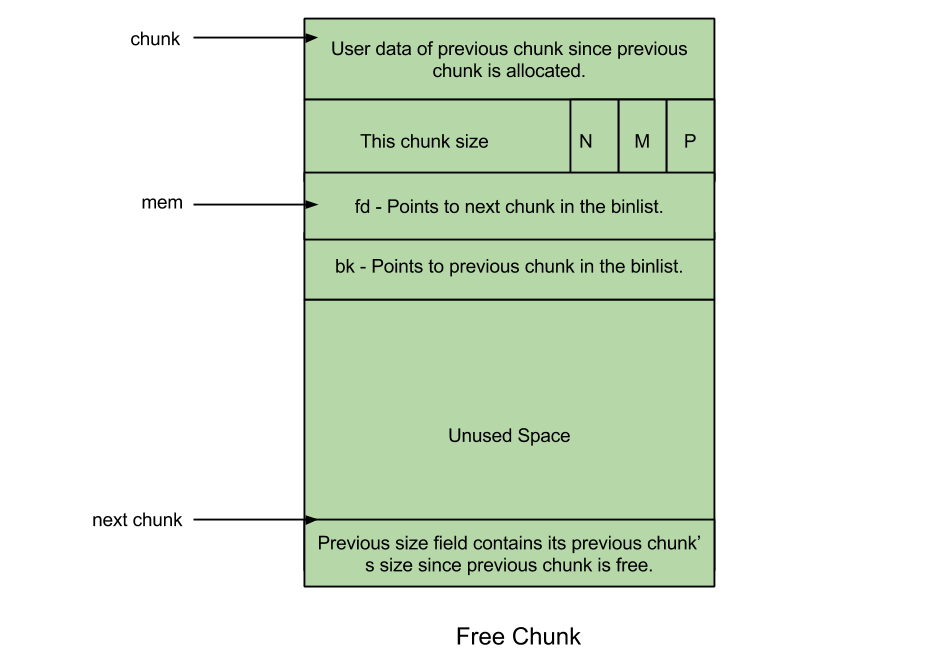
圖中結構體內部各字段的含義依次為:
prev_size: 兩個相鄰 free chunk 會被合并成一個,因此該字段總是保存前一個 allocated chunk 的用戶數據;
size: 該字段保存本 free chunk 的大小;
fd: Forward pointer —— 本字段指向同一 bin 中的下個 free chunk(free chunk 鏈表的前驅指針);
bk: Backward pointer —— 本字段指向同一 bin 中的上個 free chunk(free chunk 鏈表的后繼指針)。
5. Bins
「bins」 就是空閑列表數據結構。它們用以保存 free chunks。根據其中 chunk 的大小,bins 被分為如下幾種類型:
Fast bin;
Unsorted bin;
Small bin;
Large bin.
保存這些 bins 的字段為:
fastbinsY: 這個數組用以保存 fast bins;
bins: 這個數組用于保存 unsorted bin、small bins 以及 large bins,共計可容納 126 個,其中:
Bin 1: unsorted bin;
Bin 2 - 63: small bins;
Bin 64 - 126: large bins.
5.1. Fast Bin
大小為 16 ~ 80 字節的 chunk 被稱為「fast chunk」。在所有的 bins 中,fast bins 路徑享有最快的內存分配及釋放速度。
數量:10
每個 fast bin 都維護著一條 free chunk 的單鏈表,采用單鏈表是因為鏈表中所有 chunk 的大小相等,增刪 chunk 發生在鏈表頂端即可;—— LIFO
chunk 大小:8 字節遞增
fast bins 由一系列所維護 chunk 大小以 8 字節遞增的 bins 組成。也即,fast bin[0]維護大小為 16 字節的 chunk、fast bin[1]維護大小為 24 字節的 chunk。依此類推……
指定 fast bin 中所有 chunk 大小相同;
在 malloc 初始化過程中,最大的 fast bin 的大小被設置為 64 而非 80 字節。因為默認情況下只有大小 16 ~ 64 的 chunk 被歸為 fast chunk 。
無需合并 —— 兩個相鄰 chunk 不會被合并。雖然這可能會加劇內存碎片化,但也大大加速了內存釋放的速度!
malloc(fast chunk)
初始情況下 fast chunck 最大尺寸以及 fast bin 相應數據結構均未初始化,因此即使用戶請求內存大小落在 fast chunk 相應區間,服務用戶請求的也將是 small bin 路徑而非 fast bin 路徑;
初始化后,將在計算 fast bin 索引后檢索相應 bin;
相應 bin 中被檢索的第一個 chunk 將被摘除并返回給用戶。
free(fast chunk)
計算 fast bin 索引以索引相應 bin;
free掉的 chunk 將被添加到上述 bin 的頂端。
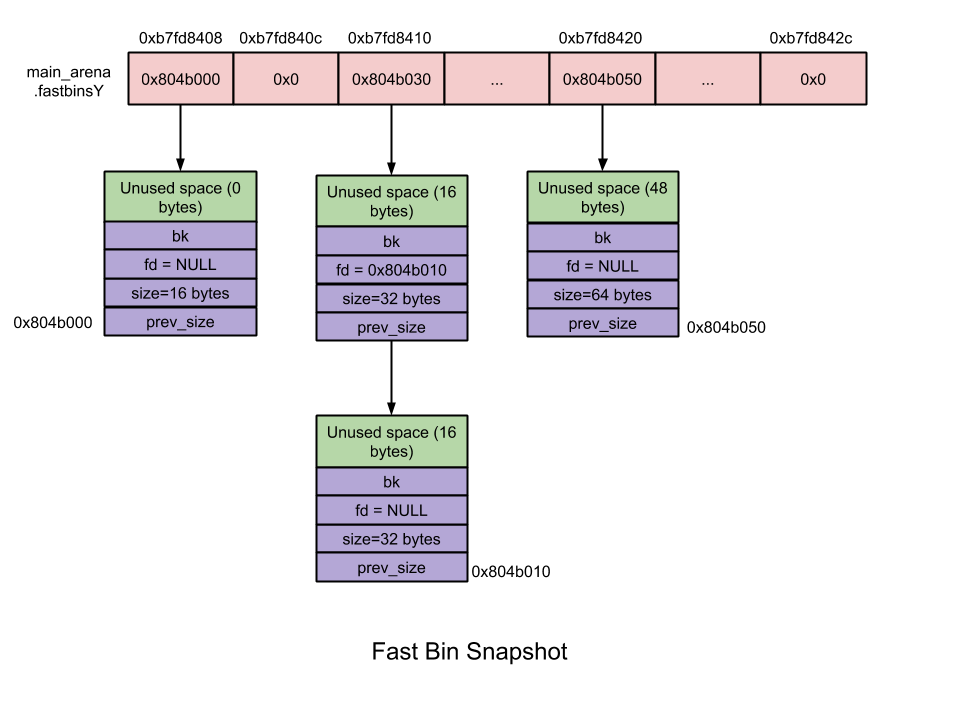
5.2. Unsorted Bin
當 small chunk 和 large chunk 被free掉時,它們并非被添加到各自的 bin 中,而是被添加在 「unsorted bin」 中。這使得分配器可以重新使用最近free掉的 chunk,從而消除了尋找合適 bin 的時間開銷,進而加速了內存分配及釋放的效率。
譯者注:經 @kwdecsdn 提醒,這里應補充說明「Unsorted Bin 中的 chunks 何時移至 small/large chunk 中」。在內存分配的時候,在前后檢索 fast/small bins 未果之后,在特定條件下,會將 unsorted bin 中的 chunks 轉移到合適的 bin 中去,small/large。
數量:1
unsorted bin 包括一個用于保存 free chunk 的雙向循環鏈表(又名 binlist);
chunk 大小:無限制,任何大小的 chunk 均可添加到這里。
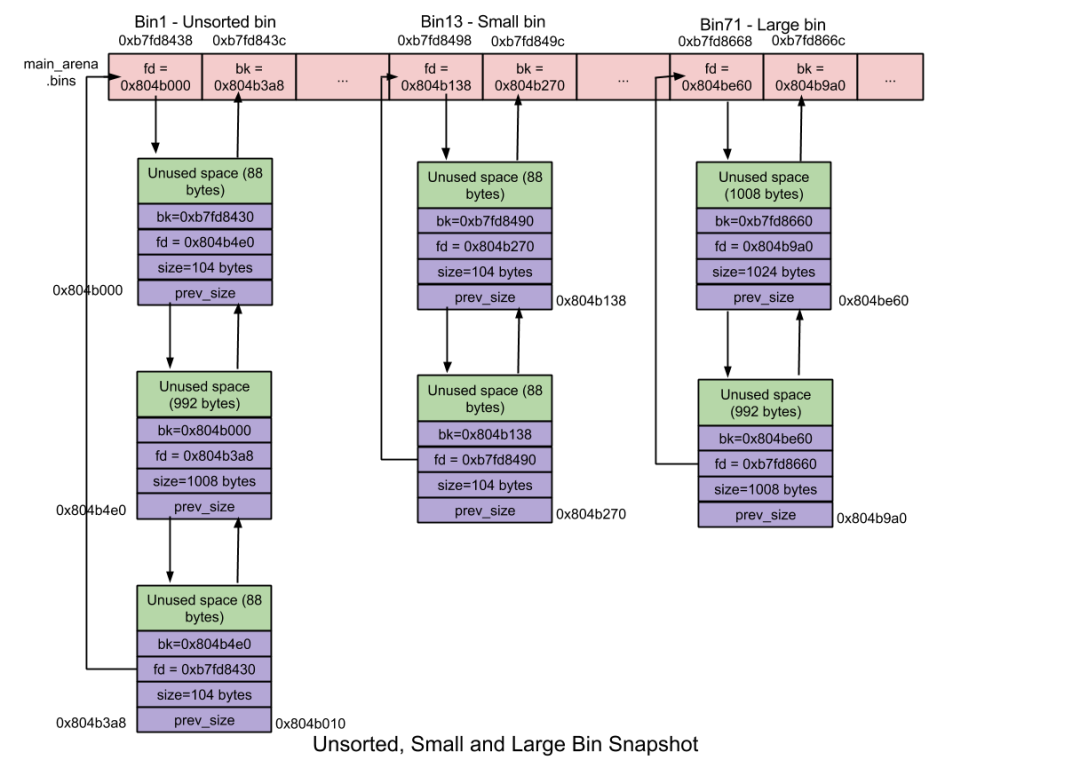
5.3. Small Bin
大小小于 512 字節的 chunk 被稱為 「small chunk」,而保存 small chunks 的 bin 被稱為 「small bin」。在內存分配回收的速度上,small bin 比 large bin 更快。
數量:62
每個 small bin 都維護著一條 free chunk 的雙向循環鏈表。采用雙向鏈表的原因是,small bins 中的 chunk 可能會從鏈表中部摘除。這里新增項放在鏈表的頭部位置,而從鏈表的尾部位置移除項。—— FIFO
chunk 大小:8 字節遞增
Small bins 由一系列所維護 chunk 大小以 8 字節遞增的 bins 組成。舉例而言,small bin[0](Bin 2)維護著大小為 16 字節的 chunks、small bin[1](Bin 3)維護著大小為 24 字節的 chunks ,依此類推……
指定 small bin 中所有 chunk 大小均相同,因此無需排序;
合并 —— 相鄰的 free chunk 將被合并,這減緩了內存碎片化,但是減慢了free的速度;
malloc(small chunk)
初始情況下,small bins 都是 NULL,因此盡管用戶請求 small chunk ,提供服務的將是 unsorted bin 路徑而不是 small bin 路徑;
第一次調用malloc時,維護在 malloc_state 中的 small bins 和 large bins 將被初始化,它們都會指向自身以表示其為空;
此后當 small bin 非空,相應的 bin 會摘除其中最后一個 chunk 并返回給用戶;
free(small chunk)
freechunk 的時候,檢查其前后的 chunk 是否空閑,若是則合并,也即把它們從所屬的鏈表中摘除并合并成一個新的 chunk,新 chunk 會添加在 unsorted bin 的前端。
5.4. Large Bin
大小大于等于 512 字節的 chunk 被稱為「large chunk」,而保存 large chunks 的 bin 被稱為 「large bin」。在內存分配回收的速度上,large bin 比 small bin 慢。
數量:63
32 個 bins 所維護的 chunk 大小以 64B 遞增,也即large chunk[0](Bin 65) 維護著大小為 512B ~ 568B 的 chunk 、large chunk[1](Bin 66) 維護著大小為 576B ~ 632B 的 chunk,依此類推……
16 個 bins 所維護的 chunk 大小以 512 字節遞增;
8 個 bins 所維護的 chunk 大小以 4096 字節遞增;
4 個 bins 所維護的 chunk 大小以 32768 字節遞增;
2 個 bins 所維護的 chunk 大小以 262144 字節遞增;
1 個 bin 維護所有剩余 chunk 大小;
每個 large bin 都維護著一條 free chunk 的雙向循環鏈表。采用雙向鏈表的原因是,large bins 中的 chunk 可能會從鏈表中的任意位置插入及刪除。
這 63 個 bins
不像 small bin ,large bin 中所有 chunk 大小不一定相同,各 chunk 大小遞減保存。最大的 chunk 保存頂端,而最小的 chunk 保存在尾端;
合并 —— 兩個相鄰的空閑 chunk 會被合并;
malloc(large chunk)
User chunk(用戶請求大小)—— 返回給用戶;
Remainder chunk (剩余大小)—— 添加到 unsorted bin。
初始情況下,large bin 都會是 NULL,因此盡管用戶請求 large chunk ,提供服務的將是 next largetst bin 路徑而不是 large bin 路徑。
第一次調用malloc時,維護在 malloc_state 中的 small bin 和 large bin 將被初始化,它們都會指向自身以表示其為空;
此后當 large bin 非空,如果相應 bin 中的最大 chunk 大小大于用戶請求大小,分配器就從該 bin 頂端遍歷到尾端,以找到一個大小最接近用戶請求的 chunk。一旦找到,相應 chunk 就會被切分成兩塊:
如果相應 bin 中的最大 chunk 大小小于用戶請求大小,分配器就會掃描 binmaps,從而查找最小非空 bin。如果找到了這樣的 bin,就從中選擇合適的 chunk 并切割給用戶;反之就使用 top chunk 響應用戶請求。
free(large chunk)—— 類似于 small chunk 。
5.5. Top Chunk
一個 arena 中最頂部的 chunk 被稱為「top chunk」。它不屬于任何 bin 。當所有 bin 中都沒有合適空閑內存時,就會使用 top chunk 來響應用戶請求。
當 top chunk 的大小比用戶請求的大小大的時候,top chunk 會分割為兩個部分:
User chunk,返回給用戶;
Remainder chunk,剩余部分,將成為新的 top chunk。
當 top chunk 的大小比用戶請求的大小小的時候,top chunk 就通過sbrk(main arena)或mmap( thread arena)系統調用擴容。
5.6. Last Remainder Chunk
「last remainder chunk」即最后一次 small request 中因分割而得到的剩余部分,它有利于改進引用局部性,也即后續對 small chunk 的malloc請求可能最終被分配得彼此靠近。
那么 arena 中的若干 chunks,哪個有資格成為 last remainder chunk 呢?
當用戶請求 small chunk 而無法從 small bin 和 unsorted bin 得到服務時,分配器就會通過掃描 binmaps 找到最小非空 bin。正如前文所提及的,如果這樣的 bin 找到了,其中最合適的 chunk 就會分割為兩部分:返回給用戶的 User chunk 、添加到 unsorted bin 中的 Remainder chunk。這一 Remainder chunk 就將成為 last remainder chunk。
那么引用局部性是如何達成的呢?
當用戶的后續請求 small chunk,并且 last remainder chunk 是 unsorted bin 中唯一的 chunk,該 last remainder chunk 就將分割成兩部分:返回給用戶的 User chunk、添加到 unsorted bin 中的 Remainder chunk(也是 last remainder chunk)。因此后續請求的 chunk 最終將被分配得彼此靠近。
-
內核
+關注
關注
3文章
1378瀏覽量
40341 -
內存
+關注
關注
8文章
3040瀏覽量
74176 -
分配器
+關注
關注
0文章
194瀏覽量
25785 -
源碼
+關注
關注
8文章
649瀏覽量
29312
原文標題:深入理解 glibc malloc:內存分配器實現原理
文章出處:【微信號:最后一個bug,微信公眾號:最后一個bug】歡迎添加關注!文章轉載請注明出處。
發布評論請先 登錄
相關推薦
音視頻/信號分配器,音視頻/信號分配器是什么意思
VGA分配器,VGA分配器是什么意思
分配器,什么是分配器

深入剖析SLUB分配器和SLAB分配器的區別





 glibc malloc內存分配器的實現原理
glibc malloc內存分配器的實現原理
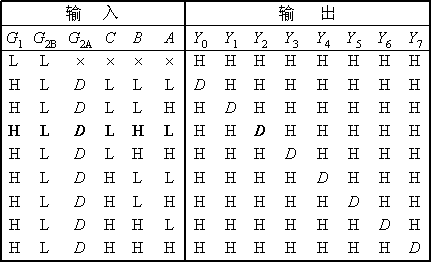












評論